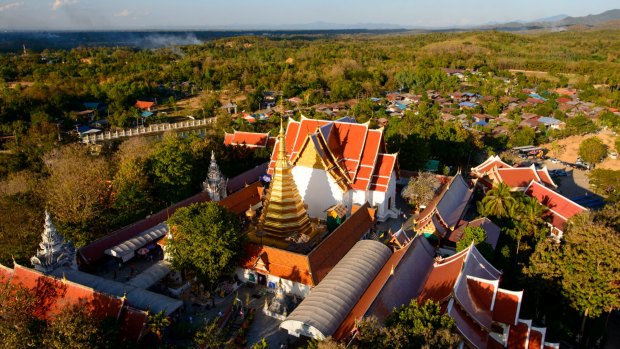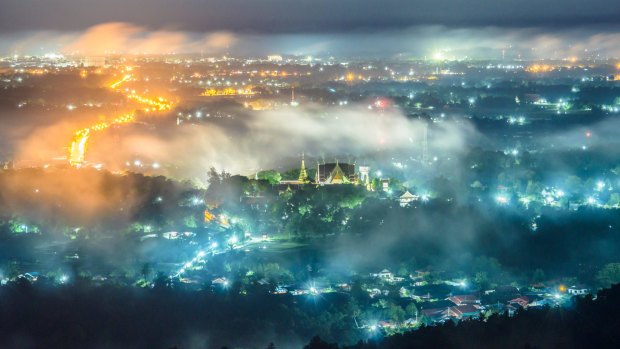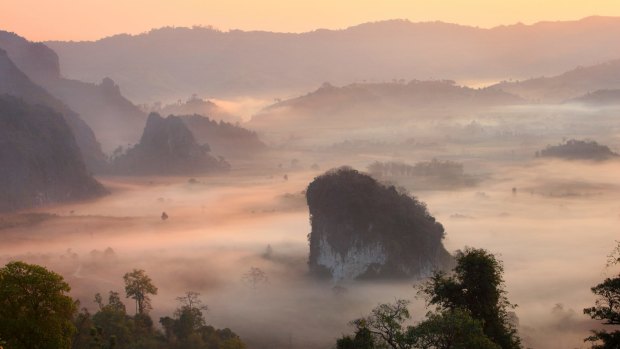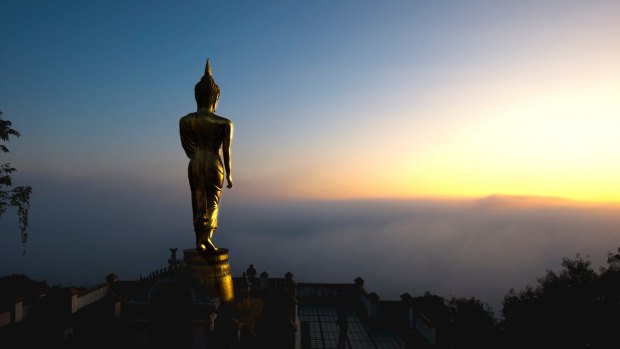By Kerry van der Jagt

Phra That Cho Hae is one of many temples to be found in and around Phrae.Credit: Hasachai Boon-nuang
If you tell anyone you're travelling to northern Thailand, most will assume you're heading to Chiang Mai or Chiang Rai. But there is another winning duo – Phrae and Nan – two historic riverside towns tucked into the country's north-east. This is the Thailand of temples and teak, of misty mountains, of whisper-soft voices with a hint of a Lao inflection. In a betel nutshell, this is the Thailand you didn't know you were missing.
Despite a dozen trips to Thailand in as many years I'd wrongly assumed these two towns were one – Phrae-nan. My second mistake was pronunciation. "Welcome to 'prayer'," says our guide, Chalarine "Cha" Phuengnoi, exhaling the word like a gentle sigh, as she greets our group at Phrae airport.
While Phrae is a 75-minute flight from Bangkok, Nan is a further 130 kilometres north-east. Both were part of the Lanna Kingdom and have cultural ties to neighbouring Laos. "Add 19th-century teak barons to the mix and you have a unique culture you won't find anywhere else in Thailand," says Phuengnoi.

Take in the spectacular scenes from the view point at Phrathat Doi Leng Temple, Phrae.Credit: Tourism Authority of Thailand
Phrae is dubbed Thailand's "teak capital" and the remains of merchants' mansions can be found dotted across the area. While many have aged naturally, their hips hunched like old men, others have been painted or polished within an inch of their lives.
"In total more than 20 buildings have been brought back to their former glory," says Phuengnoi, as we pull up in front of Wat Chom Sawan, a teak temple built in traditional Burmese style.
Squinting into the sunshine, I pause to buy flowers from an elderly woman who has set up a stall at the entrance to the temple. As she hands me the sweet-smelling bouquet she leans closer. "May love and peace accompany your journey," translates Phuengnoi. A heartfelt blessing, a connection with a stranger, a "gift", if you will; these are the joys of travelling away from the tourist trail.

Phrae and Nan are found in north-east Thailand.Credit: Tourism Authority of Thailand
From here we enter the town proper, crossing the ancient moat and remains of the city wall to the Old Town, a compact grid of leafy streets where the only requirement is to wander at will or peek inside another temple (of which the city has more than 20).
The unhurried pace reminds me of Luang Prabang in Laos, yet the refreshing lack of fridge-magnet attractions has kept all but the most curious travellers at bay. Wandering through the markets we are the novelty, attracting friendly smiles from the older folk and requests for photographs from the younger ones.
We delight in this rarity as we stroll through the quiet streets, past trees dripping with bulbous breadfruit and alongside the Yom River, swollen from the recent rains. Men with matchstick legs sit at corner cafes, while women on scooters motor past, their white clothing billowing like sails.

Wat Phra That Khao Noi in the riverside town of Nan.Credit: Tourism Authority of Thailand
We've arrived during Buddhist Lent, a period of three lunar months during the wet season, when monks retreat to their temples and devout women dress in white. "During this time women sleep on hard floors, abstain from toxins and forgo the evening meal," explains Phuengnoi. "In Bangkok everyone is so busy you wouldn't even know it was Lent."
The delights continue at Wat Phong Sunan, a temple with a gleaming white chedi consisting of 108 spires that look like whipped meringue. By chance we meet Phrakhrukowitarttawatec, the temple's abbot whose tongue-twisting name (which was awarded by the late King of Thailand no less) means "venerable wise man who is a good teacher and speaker".
After checking we have spelled his name correctly, the venerable one whips out his iPad to take our photo and asks if he can add us on Facebook. We learn that we are the first Australian visitors he has received and he wants the world to know.
Another of the treats of northern Thailand is the cuisine, particularly the Khan Toke banquet we sample one evening at Vongburi House. Built in 1897 for the ruling Vongburi family, this pretty-in-pink mansion is Barbie Dreamhome meets the gingerbread house. After a tour of the museum we gather cross-legged around a small timber table as a wheel of delectable dishes is brought out: sour and salty pomelo salad, spicy coconut soup, slow cooked pork curry with Burmese spices, deep-fried chicken and rice cakes topped with fried pork. Being Lent there's no alcohol, instead a purple-coloured cordial made from pea flower quenches our thirst.
We are immersed in more purple the next morning on the drive to Nan when we stop at Ban Thung Hom to learn about indigo. Used by ancient civilisations in Mesopotamia, Egypt, Peru, Africa, Iran and Japan, indigo was once the most important dye in the world.
Today the village of Ban Thung Hom has received OTOP certification (One Village, One Product) for its dedication to the ancient craft. "The indigo plant – Baphicacanthus cusia Bremek– needs high altitude for optimum growth," says Phuengnoi. "Indigo produced in the Phrae and Nan provinces is considered by many to be the best in Thailand."
The village streaks past in a blaze of electric blue, clotheslines are hung with metres of cobalt cloth, shopfronts are shaded with indigo awnings, mannequins shimmer in an ocean of tie-died skirts, and men wander by in their best moh hom shirts.
We join a workshop in a family's backyard, spellbound, as the dye changes like magic from yellow to blue when it is exposed to oxygen, before dipping, dying and drying a small scarf of our own. Afterwards, we go shopping for well-made pieces of hippie-inspired clothing, the experience and products a world away from tourist markets.
Riverside Nan arrives in a wash of gold temples and verdant hills. Established in the 13th century it was once a separate autonomous kingdom strategically located midway between Chiang Mai and Luang Prabang.
Our days pass easily, from attending morning alms to learning to prepare floral tributes at Noble House, one of Nan's most famous teak mansions. Temples are an allsorts collection of styles and colours, from white and gold to lilac and mint. One morning we visit Wat Phumin, famous for murals showing quiet rural scenes alongside vivid depictions of hell, on another we visit a bicycle museum housed at the back of a service station. When our feet grow weary we enjoy a lap of the city in one of its colourful trams.
On our final night we head to a sweet shop called Khong Wan Pa Nim, so famous that wealthy people are known to fly from Bangkok just for dessert. A 10-minute drive brings us to a muddy, pot-holed lane where "Aunty Nim" has been serving sweet treats for 40 years.
While I'd expected typical mango and sticky rice dessert we are served Bua Loy, or Floating Lotus, an intriguing concoction made from sticky rice flower, pumpkin and coconut meat cooked in sweet syrup and served with a poached egg. Like the twin towns of Phrae and Nan, the combination of simple yet complex ingredients produces alchemy. A wise traveller would get here before word gets out.
TRIP NOTES
Kerry van der Jagt was a guest of the Tourism Authority of Thailand.
MORE
FLY
Thai Airways International flies daily from Sydney, Melbourne, Brisbane and Perth to Bangkok. See thaiairways.com. Nok Air flies to both Phrae and Nan from Bangkok's Don Mueang airport. See nokair.com
STAY
Pukha Nanfa Hotel is a 14-room boutique hotel in Nan housed in a restored teak mansion. See pukhananfahotel.co.th
TOUR
Absolutely Fantastic Holidays can tailor multi-day tours to Phrae and Nan. See absolutelyfantasticholidays.com
Sign up for the Traveller Deals newsletter
Get exclusive travel deals delivered straight to your inbox. Sign up now.